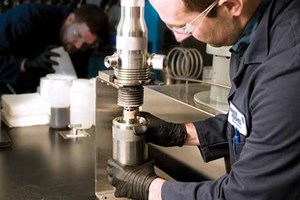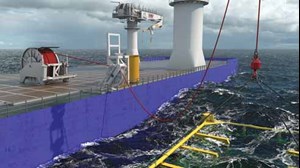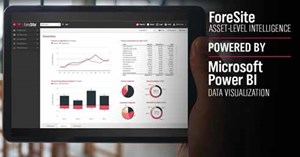Innovations improve efficiencies, deliver operator value
This year at ATCE, service providers are showcasing technologies engineered to increase efficiencies in difficult offshore environments, in extended reach drilling operations and to enhance digital intelligence platforms designed to optimize productivity.
DRILLING FLUID MINIMIZES RISK IN NARROW PRESSURE WINDOWS
In challenging offshore wells, pore pressure, fracture gradient, and complex geometry combine to create a narrow operating window. Numerous operational problems—such as excessive surge pressures, pressure spikes due to pump initiation pressures, complicated equivalent circulating density (ECD) management, and the inability to effectively control drilling parameters—can result in costly and time-consuming events.
In recent years, the typical solution for overcoming these challenges has been a low ECD drilling fluid. Although these fluid types are often effective at reducing many of the risks associated with drilling these formations, they are still susceptible to pressure spikes, barite sag, and surge pressures. Because of this, they often can’t reliably or efficiently meet an operator’s drilling objectives.
To address these challenges, Baker Hughes, a GE company, introduced the DELTA-TEQ low-pressure-impact drilling fluid, a non-aqueous fluid designed specifically to drill in narrow windows, Fig. 1. Featuring a formulation of specialized clay and polymers, the DELTA-TEQ fluid creates a non-progressive gel structure that reduces hydraulic impact with a rapid-set/easy-break profile. This profile maintains fluid integrity if operations are paused, mitigates pressure spikes when circulation resumes, and protects the formation from surge pressures when running casing.
In addition, the DELTA-TEQ fluid manages hydraulic impact by maintaining an optimal viscosity in the target areas of the well for superior hole cleaning and ROP without putting excess pressure on the formation. The fluid acts as a “viscosity clutch,” as it engages viscosity at low shear rates and disengages at high shear rates. DELTA-TEQ has been used in the North Sea, as well as deepwater Mexico, Brazil, and the Gulf of Mexico.
NEW MWD TOOL INCREASES DIRECTIONAL DRILLING EFFICIENCY
Halliburton released QuickPulse automated directional gamma service, a new measurement-while-drilling technology that provides quick and reliable downhole information at extended depth to deliver wells faster, Fig. 2. This capability helps operators drill longer laterals, improve wellbore placement and reduce well time to maximize their asset values.
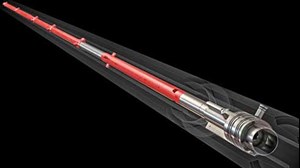
The QuickPulse system combines directional, vibration and gamma ray sensors with strong mud pulse telemetry that overcomes most downhole interference. It transmits data in intervals as fast as three seconds and full survey measurements in as little as 24 sec. The system automatically prioritizes time sensitive information, such as vibration, tool face and downhole inclination, enabling rapid drilling decisions.
At surface, the signal is automatically decoded, and the measurement data processed, removing the need for a telemetry specialist to be constantly on site. This feature, combined with a small footprint, allows for up to 70% faster rig-up time, and ensures that QuickPulse is easy and intuitive to use. The system also was engineered to make drilling a safer operation. Downhole, the tool is secured in a keyed landing sub, which improves directional control and reduces the risk of collision. Pressure relief valves on the batteries remove potential exposure of personnel to venting hazards.
Operators adopted QuickPulse early to increase rig efficiency and reduce well cycle time. In Canada, it helped reduce connection time by up to 30%, due to faster survey transmission. In the Bakken formation, another operator reported a significant increase in sliding efficiency and directional control that resulted in breaking the rig’s record for drilling the curve, lowering the section’s duration by 30%, compared to the previous record.
New digital technologies. Halliburton also released four new DecisionSpace 365 cloud applications that leverage advances in digital technology to help operators reduce exploration risk, improve reservoir characterization and boost drilling efficiency.
Scalable Earth Modeling is a high-fidelity, fast earth modeling solution that uses all available data, without upscaling, to produce rock property models that can be interrogated across all scales of resolution.
Full-Scale Asset Simulation performs multiple and fully coupled sub-surface/surface scenarios to define the optimal field development plan.
Data Foundation is a holistic, multi-model application leveraging multiple cloud native data stores to ingest, manage and access sub-surface, engineering, log, seismic and corporate data.
Real-Time Control—Edge application enables seamless data integration with wellsite advisory solutions. Information from the application delivers automated, consistent and reliable execution of the well plan.
PATENTED FIBER ROPE INCREASES LIFTING CAPACITY
National Oilwell Varco (NOV) has developed and patented the Fathom fiber rope extension system for use in offshore applications. The primary purpose of using the system is to expand the working range of a crane while increasing lifting capacity in deeper waters. This can be accomplished without the need for any significant design changes to the original crane.
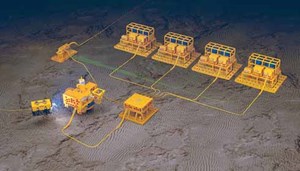
In the Fathom system, fiber rope is used as an extension of the steel wire rope installed on an offshore crane through a series of connection balls and rope segments. The submerged hookload will be equal to the crane’s safe working load reduced by the weight of submerged fiber rope, including hardware terminations, loose gears, steel wire rope payed out, and the traveling connector. The result is greater lifting capacity when compared to a steel wire crane.
The fiber rope is stored on a separate reel with a spooling device, and it can be crane-mounted or deck-mounted, giving customers the opportunity to move the system between vessels. The complete Fathom system includes: 1) a rope storage reel with a spooling device; 2) overturning sheave with or without load hang-off; 3) travelling connector fixed to the main winch steel rope; and 4) sections of fiber rope connected with standard spliced eyes in a connecting ball, Fig. 3.
Fathom provides significant benefits. Foremost is that it offers five times greater lifting capacity than wire rope crane at 5,000 m. Fathom allows operators to perform the same job with a much smaller crane, due to the low weight of the fiber rope, which allows better hoisting capacity utilization. For example, using Fathom allows a subsea lift in an ultra-deepwater application to be completed without crane capacity loss. The Fathom system is verified by DNV-GL for offshore fiber ropes and offshore and platform lifting appliances, reaffirming a commitment to quality and safety, Fig. 4.
SUBSEA PUMPING TECHNOLOGY REDUCES TOPSIDE FOOTPRINT
Oceaneering’s subsea pumping technology (SPT) enables both unmanned and subsea production factories by offering operators the ability to reduce or eliminate their topside footprint by moving chemical storage and injection systems to the seafloor, Fig. 4.
SPT combines elements of chemical storage and injection systems technology—electric pumps, fluid storage and accompanying controls—into dedicated modules, which are placed on the seafloor near subsea production infrastructure. This enables the reduction and removal of dedicated chemical and hydraulic lines in complex and costly umbilicals.
By moving equipment local to the well, SPT facilitates faster response times for chemical delivery compared to a standard umbilical. Not only can operators save time, but they can reduce capex associated with long-length step outs (>30 miles/50km) by 50% versus traditional methods.
SPT is scalable to meet field requirements and the fluid storage modules can be set up with a pair of 1,500-gallon bladders in the ISO container-dimensioned frame. This configuration makes the system road transportable, and two additional frames can be connected to supply up to 6,000 gallons of fluids for the well. The bladders can either be refilled subsea or empty modules can be retrieved and replaced. The systems can also be deployed from a multi-service vessel, eliminating the requirement for a large intervention vessel.
There are three primary applications for SPT: 1) greenfield applications, where storage and injection are required for production operations from day one; 2) brownfield applications, where chemical injection is contingent upon requirements during operation of subsea facilities, or where there has been a change in system capacity; and 3) intervention and/or other batch dose environments, where one-off chemical treatments (e.g., a corrosion inhibition batch, and startup and shutdown chemicals) are required.
For more information, visit: https://www.oceaneering.com/subsea-pumping-technology/
AI UPGRADE ENABLES CUSTOMIZED PRODUCTION OPTIMIZATION
Weatherford has integrated Microsoft Power BI into its ForeSite production optimization platform. This commingling of technologies accelerates ForeSite’s ability to perform in-depth analysis into an operator’s production data and create elegant, easy-to-digest data visualizations that illustrate virtually any production scenario from the well to asset level, Fig. 5.
Power BI features are fully integrated into the ForeSite optimization workflow, enabling visual data exploration to condense vast amounts of oilfield data from any corporate data source into actionable dashboards and reports. ForeSite users will be able to create and visualize customized data reports or select from a series of built-in visualization dashboards and reports that monitor KPIs and identify production optimization opportunities. Among the pre-built, production-data analysis package are:
- Financial health report lets users assess production versus spend by job, by service provider, by asset group, and more. This leverages data from the ForeSite field services management module.
- Failure analytics report lets user assess current and historical failure data to gain insight into vendor or technology efficiency, including equipment performance of two or more vendor brands to determine the lowest total cost of ownership.
- Asset performance dashboard gives real-time update on preset KPIs, including production targets, asset downtime and uplift potential.
- Manager’s report gives a broad, asset-level performance visualization for an asset or enterprise, including estimated versus actual spend and production.
“By fully integrating Power BI into our powerful ForeSite platform, we’re helping our customers see their production data in a way that’s easily accessible and visually informative, yet requires less preparation and data-science expertise,” says Manoj Nimbalkar, Weatherford V.P. “We’re putting asset-level intelligence and data reporting at the operator’s fingertips.”
Introduced in May 2017, ForeSite remains the only enterprise-level platform to optimize the complete life-of-well productivity from downhole to the point of sale. The platform combines physics-based models with advanced data analytics to improve performance across wells, reservoirs, and surface facilities on a single, secure platform. It optimizes naturally flowing wells, reciprocating rod lift, ESP, gas lift, plunger lift, injection wells, PCPs, and soon hydraulic lift. WO
Related Articles- Digital transformation/Late-life optimization: Harnessing data-driven strategies for late-life optimization (March 2024)
- The reserves replacement dilemma: Can intelligent digital technologies fill the supply gap? (March 2024)
- Digital tool kit enhances real-time decision-making to improve drilling efficiency and performance (February 2024)
- Digital transformation: Digital twins help to make the invisible, visible in Indonesia’s energy industry (January 2024)
- Driving MPD adoption with performance-enhancing technologies (January 2024)
- Digital transformation: A breakthrough year for digitalization in the offshore sector (January 2024)
- Applying ultra-deep LWD resistivity technology successfully in a SAGD operation (May 2019)
- Adoption of wireless intelligent completions advances (May 2019)
- Majors double down as takeaway crunch eases (April 2019)
- What’s new in well logging and formation evaluation (April 2019)
- Qualification of a 20,000-psi subsea BOP: A collaborative approach (February 2019)
- ConocoPhillips’ Greg Leveille sees rapid trajectory of technical advancement continuing (February 2019)

